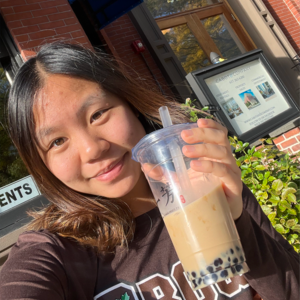I never really liked eggplants growing up, but in the past few months, I’ve stepped out of my comfort zone in adjusting to the college lifestyle, and by extension, my diet. One of my successful ventures in trying different foods was this yuxiang eggplant dish (鱼香茄子) that I tried at several Chinese restaurants with some friends. I had always found the slimy texture of eggplant off-putting, but these restaurants made the eggplants crispy and bursting with flavor – and I knew I had to recreate it myself.
The literal translation for yuxiang eggplant is “fish-fragrant” eggplant, named after the sauce’s ability to cover up even the most pungent fish. However, this recipe does not have fish and is completely vegetarian. Although there are slight variations, the main ingredients to the yuxiang sauce you’ll see in this recipe are doubanjiang, black vinegar, garlic, ginger, sugar, and soy sauce. Of these, doubanjiang and black vinegar may be unfamiliar: Doubanjiang, alternatively spelled toban-djan, is a spicy fermented soybean sauce with an earthy, nutty taste along hints of sweetness. Black vinegar is a grain-based, aged vinegar that has umami and earthy notes, compared to the blunt sourness of white vinegar.
Although they are not integral to yuxiang sauce, shaoxing wine and sesame oil are two ingredients that develop the sauce to the next level. Shaoxing wine is a fermented rice wine that brings a richer color to the flavor profile of the dish. This added aroma is said to be slightly nutty and caramel-like. Sesame oil develops the nutty tones of the sauce while also toning down the heat of the doubanjiang and acidity of the black vinegar.
Yuxiang sauce is very versatile and works great with pretty much any stir-fried food out there, especially if you’re looking for a unique garlicky, spicy kick. Yuxiang eggplant is relatively easy and quick to make, so I hope you give it a try!
Some Sidenotes
1. Other eggplant varieties like American and Italian eggplants can be used instead of Chinese or Japanese eggplants, but they may require soaking the eggplant strips in saltwater in order to reduce the bitterness and soften the skin.
2. Feel free to customize this dish by adding any proteins! In particular, ground pork and mushrooms are great for adding extra layers of flavor. Like the eggplant, these ingredients should be cooked beforehand, then added in after the sauce has been cooked.

Yuxiang Eggplant
Ingredients
Instructions

Quarter the eggplants lengthwise, then cut into 2-3 inch strips. Finely chop 1 tbsp of garlic (about 3 cloves), and 2 tbsp of ginger (about a 2-inch block).

In a bowl, combine 1.5 tbsp sugar, 1 tsp soy sauce, 2 tbsp black vinegar, 2 tsp sesame oil, and 1 tbsp shaoxing wine. Mix well.

In a different bowl, combine 1 tbsp of flour and 4 tbsp water. Stir until the slurry is homogeneous.

Add 2 tbsp of cooking oil to a pan on medium heat. When the oil is hot, place the eggplant strips into the pan, with the white eggplant flesh facing the bottom. Cook for 5-6 minutes until tender – the flesh should be nicely browned, and the deep purple skin should become a light, almost translucent purple. Remove the eggplant strips from the pan and set them aside.

To the same pan on medium heat, add 2 tbsp of cooking oil and the minced garlic and ginger. Fry until fragrant, slightly browning the garlic and ginger – be careful not to burn them.

Add in 2 tbsp of doubanjiang and mix everything together. Let the mixture cook for 1 minute.

Carefully pour in the sauce base and stir everything together again. Let the sauce reduce for 2 minutes so the flavors can combine.

Pour the flour slurry into the sauce and mix. The sauce should thicken right away and become lighter in color.

Add the cooked eggplant strips back into the pan, and stir everything together, making sure the sauce coats the eggplant nicely. Top with chopped scallions and sesame seeds to garnish.



